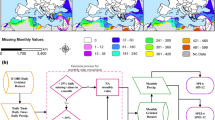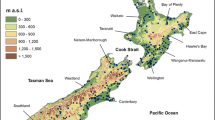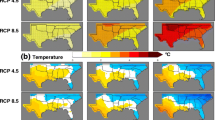Abstract
The study presents a methodology to characterise short- or long-term drought events, designed to aid understanding of how climate change may affect future risk. An indicator of drought magnitude, combining parameters of duration, spatial extent and intensity, is presented based on the Standardised Precipitation Index (SPI). The SPI is applied to observed (1955–2003) and projected (2003–2050) precipitation data from the Community Integrated Assessment System (CIAS). Potential consequences of climate change on drought regimes in Australia, Brazil, China, Ethiopia, India, Spain, Portugal and the USA are quantified. Uncertainty is assessed by emulating a range of global circulation models to project climate change. Further uncertainty is addressed through the use of a high-emission scenario and a low-stabilisation scenario representing a stringent mitigation policy. Climate change was shown to have a larger effect on the duration and magnitude of long-term droughts, and Australia, Brazil, Spain, Portugal and the USA were highlighted as being particularly vulnerable to multi-year drought events, with the potential for drought magnitude to exceed historical experience. The study highlights the characteristics of drought which may be more sensitive under climate change. For example, on average, short-term droughts in the USA do not become more intense but are projected to increase in duration. Importantly, the stringent mitigation scenario had limited effect on drought regimes in the first half of the twenty-first century, showing that adaptation to drought risk will be vital in these regions.



Similar content being viewed by others
References
Barker T, Pan H, Kohler J, Warren R, Winne S (2006) Avoiding dangerous climate change by inducing technological progress: scenarios using a large-scale econometric model. In: Schellnhuber HJ, Cramer W, Nakicenovic N, Wigley T, Yohe G (eds) Avoiding dangerous climate change. Cambridge University Press, Cambridge, pp 361–372
Bates BC, Kundzewicz ZW, Wu S, Palutikof J (eds) (2008) Climate change and water. Technical Paper of the Intergovernmental Panel on Climate Change. IPCC Secretariat, 210 pp, Geneva
Blenkinsop S, Fowler HJ (2007) Changes in European drought characteristics projected by the PRUDENCE regional climate models. Int J Climatol 27:1595–1610
Burke EJ, Brown SJ (2008) Evaluating uncertainties in the projection of future drought. J Hydrometeorol 9(2):292–299. doi:10.1175/2007jhm929.1
Burke EJ, Brown SJ, Christidis N (2006) Modeling the recent evolution of global drought and projections for the twenty-first century with the Hadley centre climate model. J Hydrometeorol 7:1113–1125
Byun H-R, Wilhite D (1999) Objective quantification of drought severity and duration. Am Meteorol Soc 12:2747–2756
Christensen JH, Hewitson B, Busuioc A, Chen A, Gao X, Held I, Jones R, Kolli RK, Kwon WT, Laprise R, Rueda VM, Mearns L, Menéndez CG, Räisänen J, Rinke A, Sarr A, Whetton P (2007) Regional climate projections. In: Qin D, Manning M, Solomon S et al (eds) Climate change 2007: the physical science basis. Contribution of Working Group I to the Fourth Assessment Report of the Intergovernmental Panel on Climate Change. Cambridge University Press, Cambridge, pp 847–945
CSIRO, Australian BoM (2007) Climate change in australia—technical report. Projections developed by CSIRO and the Australian BoM for the Australian Climate Change Science Programme.
EM-DAT (2012) EM-DAT: the OFDA/CRED International Disaster Database. Université Catholique de Louvain - Brussels - Belgium. www.em-dat.net
Gao X, Shi Y, Song R, Giorgi F, Wang Y, Zhang D (2008) Reduction of future monsoon precipitation over China: comparison between a high resolution RCM simulation and the driving GCM. Meteorol Atmos Phys 100:73–86
Giorgi F, Francisco R (2000) Uncertainties in regional climate change prediction: a regional analysis of ensemble simulations with the HADCM2 coupled AOGCM. Climate Dynamics 16:169–182
Goodess CM, Osborn TJ, Hulme M (2003) The identification and evaluation of suitable scenario development methods for the estimation of future probabilities of extreme weather events. Tyndall Centre for Climate Change Research Technical Report 4. Tyndall Centre for Climate Change Research, Norwich
Guttman NB (1998) Comparing the palmer drought index and the standardized precipitation index. J Am Water Resour Assoc 34(1):113–121
Guttman NB (1999) Accepting the standardized precipitation index: a calculation algorithm. J Am Water Resour Assoc 35(2):311–322
Hirabayashi Y, Kanae S, Emori S, Oki T, Kimoto M (2008) Global projections of changing risks of floods and droughts in a changing climate. J Hydrol Sci 53(4):754–772
IPCC (2001) In: Houghton JT, Ding Y, Griggs DJ, Noguer M, van der Linden PJ, Dai X, Maskell K, Johnson CA (eds) Climate change 2001: the scientific basis. Contribution of Working Group I to the Third Assessment Report of the Intergovernmental Panel on Climate Change. Cambridge University Press, Cambridge
IPCC (2007a) In: Solomon S, Qin D, Manning M, Chen Z, Marquis M, Averyt KB, Tignor M, Miller HL (eds) Climate change 2007: the physical science basis. Contribution of Working Group I to the Fourth Assessment Report of the Intergovernmental Panel on Climate Change, vol 1. Cambridge University Press, Cambridge
IPCC (2007b) In: Parry ML, Canziani OF, Palutikof JP, van der Linden PJ, Hanson CE (eds) Climate change 2007: impacts, adaptation and vulnerability. Contribution of Working Group II to the Fourth Assessment Report of the Intergovernmental Panel on Climate Change, vol 2. Cambridge University Press, Cambridge
IPCC (ed) (2012) Managing the risks of extreme events and disasters to advance climate change adaptation. A Special Report of Working Groups I and II of the Intergovernmental Panel on Climate Change. Cambridge University Press, Cambridge, UK
Jenkins K (2012) Modelling the economic and social consequences of drought under future projections of climate change. Dissertation. University of Cambridge, Avaliable at: http://www.dspace.cam.ac.uk/handle/1810/242439
Jenkins K (2013) Indirect economic losses of drought under future projections of climate change: a case study for Spain. Nat Hazards 69(3):1967–1986. doi:10.1007/s11069-013-0788-6
Keyantash J, Dracup JA (2002) The quantification of drought: an evaluation of drought indices. Bull Am Meteorol Soc 83(8):1167–1180
Kim D-W, Byun H-R (2009) Future pattern of Asian drought under global warming scenario. Theor Appl Climatol 98:137–150
Kirono DGC, Kent DM (2011) Assessment of rainfall and potential evaporation from global climate models and its implications for Australian regional drought projection. Int J Climatol 31(9):1295–1308. doi:10.1002/joc.2165
Lehner B, Döll P, Alcamo J, Henrichs T, Kaspar F (2006) Estimating the impact of global change on flood and drought risks in Europe: a continental, integrated analysis. Clim Chang 75:273–299
Li W, Fu R, Juárez RIN, Fernandes K (2008) Observed change of the standardized precipitation index, its potential cause and implications to future climate change in the Amazon region. Philos Trans R Soc, B 363(1498):1767–1772. doi:10.1098/rstb.2007.0022
Lloyd-Hughes B, Saunders MA (2002) A drought climatology for Europe. Int J Climatol 22:1571–1592
Lynch A, Nicholls N, Alexander L, Griggs D (2008) Garnaut Climate Change Review. Defining the impacts of climate change on extreme events. Submission Report commissioned by the Garnaut Climate Change Review. Monash University
Marengo JA, Jones R, Alves LM, Valverde MC (2009) Future change of temperature and precipitation extremes in South America as derived from the PRECIS regional climate modeling system. Int J Climatol 29(15):2241–2255
McKee TB, Doesken NJ, Kleist J (1993) The relationship of drought frequency and duration to time scales. In: Eighth conference on applied climatology, 17-22 January 1993, Anaheim, California, 17-22 January 1993 p 6
Mitchell TD (2003) Pattern scaling: an examination of the accuracy of the technique for describing future climates. Clim Chang 60:217–242
Mitchell TD, Jones PD (2005) An improved method of constructing a database of monthly climate observations and associated high-resolution grids. Int J Climatol 25:693–712
Mu Q, Zhao M, Kimball SJ, McDowwell N, Running SW (2013) A remotely sensed global terrestrial drought severity index. Bull Am Meteorol Soc 94(1):83–98
NARCCAP (North American Regional Climate Change Assessment Program) (2007) Climate Change Results. University Corporation for Atmospheric Research Accessed 14th July 2010
NDMC (2006a) Impacts of droughts. Avaliable at: http://drought.unl.edu/Planning/Impacts.aspx. Accessed 9th June 2010
NDMC (2006b) Interpretation of SPI maps.
Redmond KT (2002) The depiction of drought. Bull Am Meteorol Soc 83(8):1143–1148
Rupa Kumar K, Sahai AK, Kumar KK, Patwardhan SK, Mishra PK, Revadekar JV, Kamala K, Pant GB (2006) High-resolution climate change scenarios for India for the 21st century. Curr Sci 90(3):334–345
Sheffield J, Wood EF (2008) Projected changes in drought occurrence under future global warming from multi-model, multi-scenario, IPCC AR4 simulations. Climate Dynamics 31:79–105
Sheffield J, Wood EF (2011) Drought: past problems and future scenarios. Earthscan, London
Trenberth KE, Guillemot CJ (1996) Physical processes involved in the 1988 drought and 1993 floods in North America. Journal of Climate 9 (6):1288-1298. doi:10.1175/1520-0442(1996)009<1288:ppiitd>2.0.co;2
Vasiliades L, Loukas A, Patsonas G (2009) Evaluation of a statistical downscaling procedure for the estimation of climate change impacts on droughts. Nat Hazards Earth Syst Sci 9(3):879–894. doi:10.5194/nhess-9-879-2009
Vidal JP, Martin E, Kitova N, Najac J, Soubeyroux JM (2012) Evolution of spatio-temporal drought characteristics: validation, projections and effect of adaptation scenarios. Hydrol Earth Syst Sci Discuss 9:1619–1670
Warren R, de la Nava Santos S, Arnell NW, Bane M, Barker T, Barton C, Ford R, Füssel HM, Hankin RKS, Klein R, Linstead C, Kohler J, Mitchell TD, Osborn TJ, Pan H, Raper SCB, Riley G, Schellnhüber HJ, Winne S, Anderson D (2008) Development and illustrative outputs of the Community Integrated Assessment System (CIAS), a multi-institutional modular integrated assessment approach for modelling climate change. Environ Model Softw 23(5):592–610. doi:10.1016/j.envsoft.2007.09.002
Warren R, Yu R, Osborn TJ, de la Nava SS (2012) European drought regimes under mitigated and unmitigated climate change: application of the Community Integrated Assessment System (CIAS). Clim Res 51(2):105–123
Weiβ M, Flörke M, Menzel L, Alcamo J (2007) Model-based scenarios of Mediterranean droughts. Adv Geosci 12:145–151
Wilhite D, Buchannan-Smith M (2005) Drought as hazard: understanding the natural and social context. In: Wilhite D (ed) Drought and water crises: science. Technology and Management Issues, Taylor & Francis, London, p 399
Wilhite DA (ed) (2005) Drought and water crises: science, technology, and management issues. Taylor & Francis, London
Wu H, Hayes MJ, Wilhite DA, Svoboda MD (2005) The effect of the length of record on the standardized precipitation index calculation. Int J Climatol 25(4):505–520
Zhang X, Zwiers FW, Hegerl GC, Lambert FH, Gillett NP, Solomon S, Stott PA, Nozawa T (2007) Detection of human influence on twentieth-century precipitation trends. Nature 448(7152):461–465
Zhao M, Running SW (2010) Drought-induced reduction in global terrestrial net primary production from 2000 through 2009. Science 329:940–943
Author information
Authors and Affiliations
Corresponding author
Electronic supplementary material
Below is the link to the electronic supplementary material.
ESM 1
(DOC 348 kb)
Rights and permissions
About this article
Cite this article
Jenkins, K., Warren, R. Quantifying the impact of climate change on drought regimes using the Standardised Precipitation Index. Theor Appl Climatol 120, 41–54 (2015). https://doi.org/10.1007/s00704-014-1143-x
Received:
Accepted:
Published:
Issue Date:
DOI: https://doi.org/10.1007/s00704-014-1143-x




